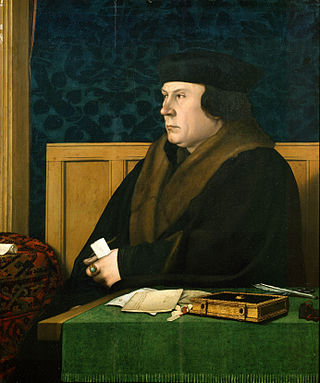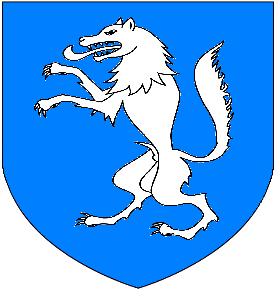Related Research Articles

Thomas Cranmer was a leader of the English Reformation and Archbishop of Canterbury during the reigns of Henry VIII, Edward VI and, for a short time, Mary I. He helped build the case for the annulment of Henry's marriage to Catherine of Aragon, which was one of the causes of the separation of the English Church from union with the Holy See. Along with Thomas Cromwell, he supported the principle of royal supremacy, in which the king was considered sovereign over the Church within his realm.

Anne of Cleves was Queen of England from 6 January to 12 July 1540 as the fourth wife of King Henry VIII. Not much is known about Anne before 1527, when she became betrothed to Francis, Duke of Bar, son and heir of Antoine, Duke of Lorraine, although their marriage did not proceed. In March 1539, negotiations for Anne's marriage to Henry began, as Henry believed that he needed to form a political alliance with her brother, William, who was a leader of the Protestants of Western Germany, to strengthen his position against potential attacks from Catholic France and the Holy Roman Empire.

Thomas Cromwell, briefly Earl of Essex, was an English statesman and lawyer who served as chief minister to King Henry VIII from 1534 to 1540, when he was beheaded on orders of the king, who later blamed false charges for the execution.

Edmund Bonner was Bishop of London from 1539 to 1549 and again from 1553 to 1559. Initially an instrumental figure in the schism of Henry VIII from Rome, he was antagonised by the Protestant reforms introduced by the Duke of Somerset and reconciled himself to Catholicism. He became notorious as "Bloody Bonner" for his role in the persecution of heretics under the Catholic government of Mary I of England, and ended his life as a prisoner under Queen Elizabeth I.
Thomas Thirlby, was the first and only bishop of Westminster (1540–50), and afterwards successively bishop of Norwich (1550–54) and bishop of Ely (1554–59). While he acquiesced in the Henrician schism, with its rejection in principle of the Roman papacy, he remained otherwise loyal to the doctrine of the Roman Catholic Church during the English Reformation.
Nicholas Shaxton was Bishop of Salisbury. For a time, he had been a Reformer, but recanted this position, returning to the Roman faith. Under Henry VIII, he attempted to persuade other Protestant leaders to also recant. Under Mary I, he took part in several heresy trials of those who became Protestant martyrs.

John Wakeman was an English Benedictine, the last Abbot of Tewkesbury and first Bishop of Gloucester, both posts in the English county of Gloucestershire. In the earlier part of his life he went by the name John Wiche.
Events from the 1530s in England.
John Capon, aliasJohn Salcot was a Benedictine monk who became bishop of Bangor, then bishop of Salisbury under Henry VIII. He is often referred to as John Salcot alias Capon.
William Barlow was an English Augustinian prior turned bishop of four dioceses, a complex figure of the Protestant Reformation. Aspects of his life await scholarly clarification. Labelled by some a "weathercock reformer", he was in fact a staunch evangelical, an anti-Catholic and collaborator in the Dissolution of the Monasteries and dismantling of church estates; and largely consistent in his approach, apart from an early anti-Lutheran tract and a supposed recantation under Mary I. He was one of the four consecrators and the principal consecrator of Matthew Parker, as archbishop of Canterbury in 1559.
John Chambers was an English Benedictine, the last Abbot of Peterborough and first Bishop of Peterborough.

Sir John Tregonwell was a Cornish jurist, a principal agent of Henry VIII and Thomas Cromwell in the Dissolution of the Monasteries. He served as Judge of the High Court of Admiralty from 1524 to 1536.
Thomas Bedyll (died 1537) was a divine and royal servant. He was royal chaplain and clerk of the Privy Council of Henry VIII, assisting him with the separation from Rome.
Sir Thomas Holcroft was a sixteenth-century English courtier, soldier, politician and landowner.
Edward Lee was Archbishop of York from 1531 until his death.
Dr Richard Gwent was a senior ecclesiastical jurist, pluralist cleric and administrator through the period of the Dissolution of the Monasteries under Henry VIII. Of south Welsh origins, as a Doctor of both laws in the University of Oxford he rose swiftly to become Dean of the Arches and Archdeacon of London and of Brecon, and later of Huntingdon. He became an important figure in the operations of Thomas Cromwell, was a witness to Thomas Cranmer's private protestation on becoming Archbishop of Canterbury, and was Cranmer's Commissary and legal draftsman. He was an advocate on behalf of Katherine of Aragon in the proceedings against her, and helped to deliver the decree of annulment against Anne of Cleves.

Gabriel Donne or Dunne was an English Cistercian monk and was the last Abbot of Buckfast Abbey in Devon, before the Dissolution of the Monasteries.
John Barber was an English clergyman and civilian.
John London, DCL was Warden of New College, Oxford, and a prominent figure in the Dissolution of the Monasteries during the reign of Henry VIII of England.
Anthony Hussey, Esquire, was an English merchant and lawyer who was President Judge of the High Court of Admiralty under Henry VIII, before becoming Principal Registrar to the Archbishops of Canterbury from early in the term of Archbishop Cranmer, through the restored Catholic primacy of Cardinal Pole, and into the first months of Archbishop Parker's incumbency, taking a formal part in the latter's consecration. The official registers of these leading figures of the English Reformation period were compiled by him. While sustaining this role, with that of Proctor of the Court of the Arches and other related ecclesiastical offices as a Notary public, he acted abroad as agent and factor for Nicholas Wotton.
References
- Attribution
![]() This article incorporates text from a publication now in the public domain : Rigg, James McMullen (1885). "Benson, William (d.1549)". In Stephen, Leslie (ed.). Dictionary of National Biography . Vol. 4. London: Smith, Elder & Co. pp. 259–260.; Endnotes:
This article incorporates text from a publication now in the public domain : Rigg, James McMullen (1885). "Benson, William (d.1549)". In Stephen, Leslie (ed.). Dictionary of National Biography . Vol. 4. London: Smith, Elder & Co. pp. 259–260.; Endnotes:
- Widmore's Hist. West. Abb. 126
- Neale and Brayley's Hist. West. Abb. i. 103
- Strype's Cranmer, bk. i. cap. vi.
- Strype's Mem. (fol.) ii. pt. i. 4
- Strype's Ann. ii. pt. ii., App. bk. i. No. xxxvii.
- Burnet's Reform. (Pocock), I. 256, 410, II. 175, i. 286, 503
- State Papers Henry VIII, i. 635
- Letters and Papers, Foreign and Domestic, Henry VIII, v. g. 166 (53), g. 278 (25), vi. 228, i. 472, 661, g. 417 (20) (21), g. 578 (25), g. 1111 (4)
- Sir Thomas More's Works (fol. London, 1537), 1430
- Ellis's Letters, 3rd ser. iii. 273
- Rymer's Fœdera (2nd ed.), xiv. 459
- Dugdale's Monast. (ed. Caley), i. 280
- Le Neve's Fasti (Hardy), iii. 346
- Kempe's St. Martin's-le-Grand, 163, 200
- Rep. Dep. Keep. Pub. Rec., App. ii. 48
- Dart's West. i. 66
- Cooper's Athenæ Cantab. i. 537.
